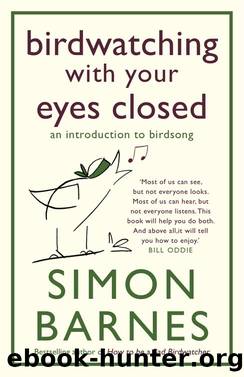Birdwatching With Your Eyes Closed by Simon Barnes

Author:Simon Barnes [Simon Barnes]
Language: eng
Format: epub
ISBN: 9781780720227
Publisher: Short Books
Published: 2011-07-14T16:00:00+00:00
Seagulls
The trouble with tuning into birdsong is that it’s hard to untune. And that can be frustrating. The birds covered in the first chunk of this book have mostly been birds you come across in gardens, parks, commons, suburbs, and birds of the accessible dog-walking countryside. But if you go to other places, other birds will make other noises – and you will hear them and wonder what they are.
Sometimes, this is like starting all over again. The point to hold onto is that this process is not without its pleasures. On my friend’s farm in Australia, or when making a trip to any part of the Americas, I find myself struggling, but once I’ve got a few calls logged in the brain, I begin to see a pattern instead of anarchy. Elsewhere in the world I have done a bit more birding, and have at least somewhere to start – but then all at once I am baffled again: a bird I have forgotten, a bird I half remember, a bird I have never encountered before: and they all sound the same …
So let’s go to the seaside. Spring is over: summer holiday has begun. And you arrive and hear seagulls. There are half a dozen species of gull you might readily encounter in this country: is it possible to separate all the screams and yelps and wahs and make sense of them?
Gulls don’t sing. They are not territorial in the manner of songbirds. But they are a gabby lot: it’s just that their range of vocabulary is used for slightly different reasons. A lot of the more spectacular and memorable calls are used in display. That is to say, it is part of a demonstration of a bird’s strength: a demonstration of potential aggression without actually fighting. The birds can almost always see each other – not always the case with songbirds when they are singing – and so the voice is there to back up intimidatory flight or posture. With a songbird, sound is the primary method of communication; with a bird in display, the sound is secondary. This sound is seldom complex: it is not intended to be. It is dramatic, though: and that’s precisely the point. The bird is, after all, showing off.
Download
This site does not store any files on its server. We only index and link to content provided by other sites. Please contact the content providers to delete copyright contents if any and email us, we'll remove relevant links or contents immediately.
Sapiens: A Brief History of Humankind by Yuval Noah Harari(13053)
The Tidewater Tales by John Barth(12030)
Do No Harm Stories of Life, Death and Brain Surgery by Henry Marsh(6336)
Mastermind: How to Think Like Sherlock Holmes by Maria Konnikova(6236)
The Thirst by Nesbo Jo(5785)
Why We Sleep: Unlocking the Power of Sleep and Dreams by Matthew Walker(5642)
Sapiens by Yuval Noah Harari(4537)
Life 3.0: Being Human in the Age of Artificial Intelligence by Tegmark Max(4508)
The Longevity Diet by Valter Longo(4445)
The Rules Do Not Apply by Ariel Levy(3906)
The Immortal Life of Henrietta Lacks by Rebecca Skloot(3826)
The Body: A Guide for Occupants by Bill Bryson(3802)
Why We Sleep by Matthew Walker(3773)
Animal Frequency by Melissa Alvarez(3755)
Yoga Anatomy by Kaminoff Leslie(3701)
Barron's AP Biology by Goldberg M.S. Deborah T(3632)
The Hacking of the American Mind by Robert H. Lustig(3580)
All Creatures Great and Small by James Herriot(3516)
Yoga Anatomy by Leslie Kaminoff & Amy Matthews(3396)
